270 Winchester vs 30-06 Springfield: Ammo Comparison
The 30-06 Springfield is frequently touted as the cartridge capable of taking any big game in North America while 270 Winchester is said to own the longer-range hunting realm. Are either of these claims true? Is 30-06 Springfield the only round you really need, or is 270 Win a clear winner if you want greater range? We’re here to settle this debate once and for all by taking a look at 270 Winchester versus 30-06 Springfield.
270 Winchester vs 30-06 Springfield Spec Comparison
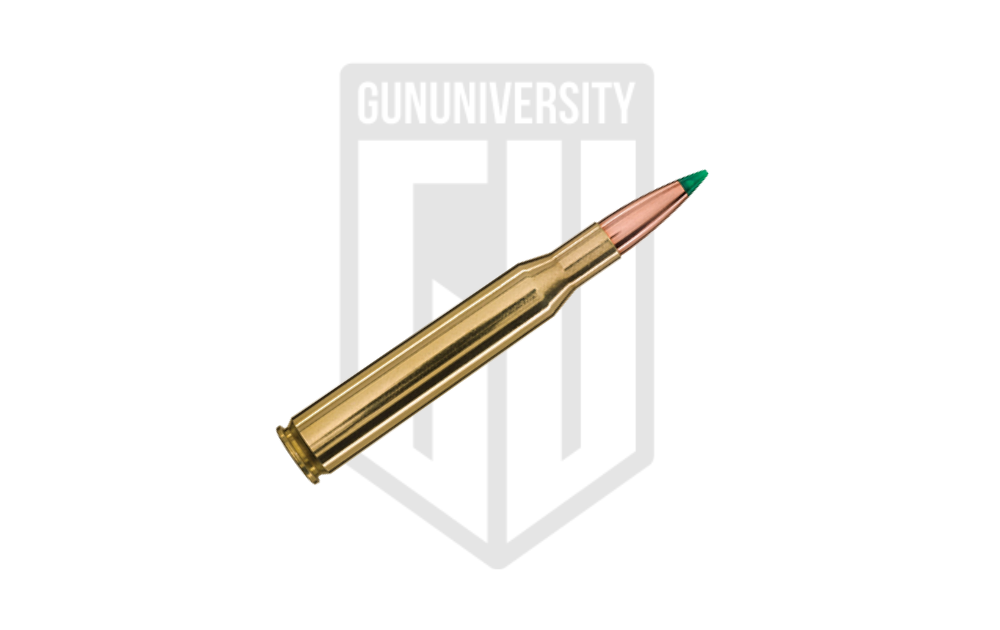
270 Winchester
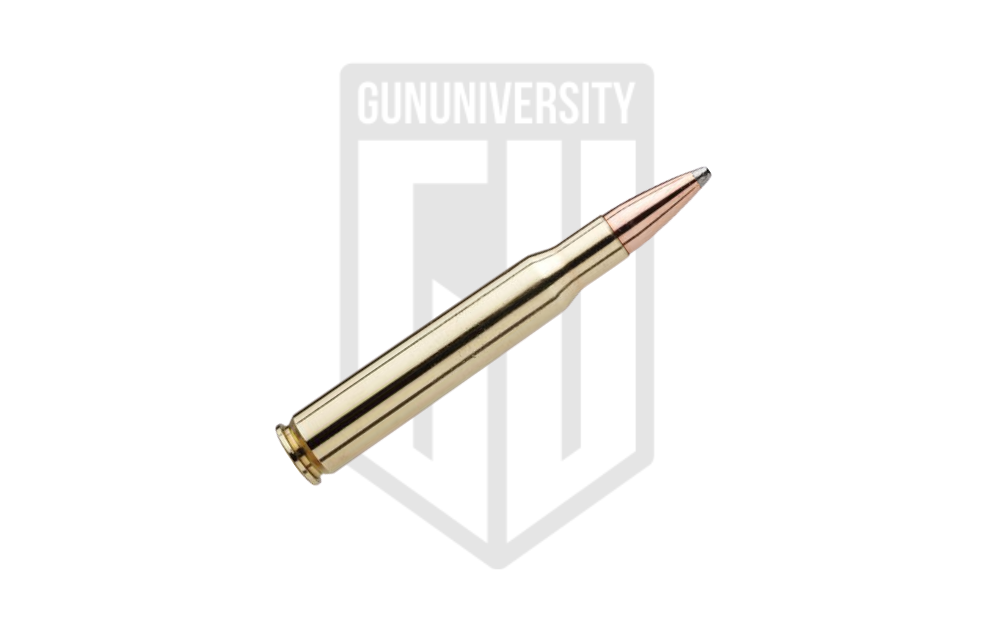
.30-06 Springfield
Why compare 270 Win vs. 30-06 Springfield?
The most obvious reason to compare 270 Win versus 30-06 Springfield is because the latter is the parent cartridge of the former. Beyond that, the two cartridges do have a history of competing against one other among hunters. Each cartridge has an established reputation, and each has a dedicated following for similar reasons.
We sometimes consider 30-06 Springfield the more outdated of the two, despite it being not that much older than 270 Win. Of course, considering the fact that 270 Win’s design was based on that of the 30-06 Springfield, you’d think that might play a role in its acceptance today (positive or negative). When it comes right down to it, the easiest way to decide which cartridge is right for you and your needs is by examining the ballistics and overall performance of the two.
It’s the cartridge vs. cartridge face-off: 270 Win vs. 30-06 Springfield.
270 Winchester Review
As of 2023, the 270 Win is officially 100 years old. That means it’s had plenty of years to not only prove itself but to enjoy advances in technology and loading practices. Whether you’re a hardcore hunter or simply looking for a new precision rifle, you’ve probably considered 270 Win. Let’s take a deeper dive into the history and performance of this round.
270 Win History and Purpose
The 270 Win sort of owes its existence to the 30-06 Springfield. Developers at Winchester who wanted to create the Next Big Thing for big game hunting designed it in 1923. The developers at Winchester accomplished this by using the existing and proven 30-06 Springfield as the parent cartridge, which made good sense considering the reputation of the older cartridge.
To create the 270 Win, a few things were done, including necking down a 30-06 Springfield case and utilizing a bullet with a diameter slightly smaller than that of its parent case. Historically, the 270 Win was the first Western-designed cartridge to have a bullet with its diameter, which is an interesting bit of trivia. They made it to produce significant velocity—greater than that of the 30-06 Springfield—while delivering an overall superior performance on big game. Of course, although it was designed with hunters in mind, it’s proven itself for other applications as well.
They launched the 270 Win in 1925 under the name 270 WCF (Winchester Centerfire), chambered for Winchester’s Model 54. It did enjoy a certain degree of popularity in its earlier decades, partly because the late outdoor writer Jack O’Connor was a fan. O’Connor was the Shooting Editor of Outdoor Life for decades, and prior to his death in 1978, he repeatedly expounded on the stellar performance of 270 Win.
Pros and Cons of 270 Winchester vs 30-06 Springfield
- Maximum Pressure – 270 Win has a higher maximum pressure which can translate to greater velocities.
- Effective Range – The effective range of 270 Win is further than that of 30-06 Springfield.
- Trajectory – 270 Win delivers a flatter trajectory than 30-06 Springfield.
- Projectile Diameter –The 270 Win has a smaller bullet diameter than 30-06 Springfield, which can mean smaller wound cavities.
- Energy – 270 Win doesn’t produce as much energy as 30-06 Springfield, meaning there isn’t as much energy to transfer on target.
Best Ammo for 270 Win
Fortunately, there are a lot of options for 270 Win ammunition. That means whatever you’re using it for, there’s probably a load out there to do it. These are our top task-specific picks for 270 Win:
Hunting Ammo
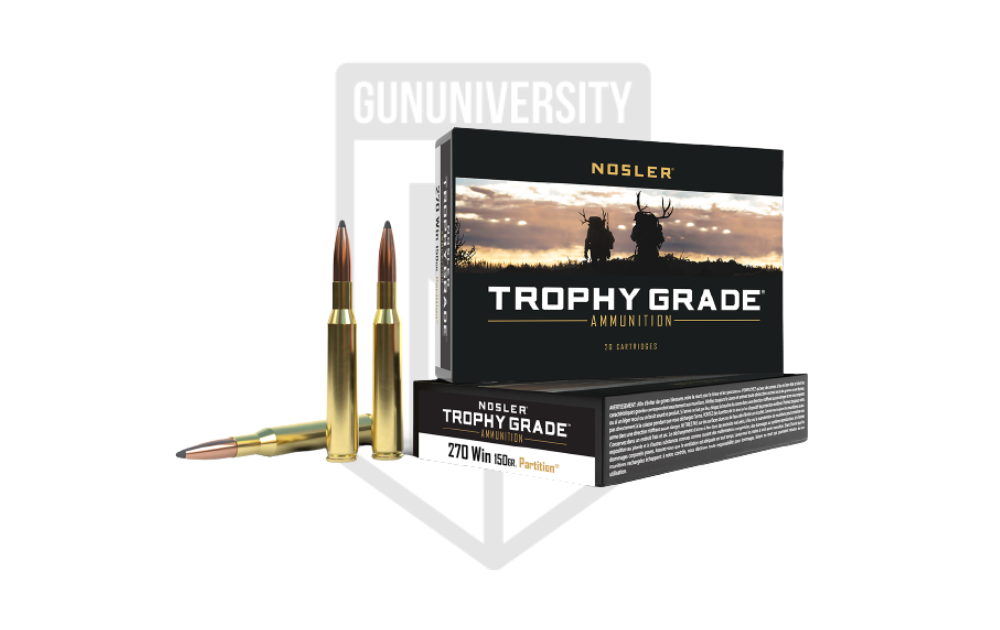
Nosler Trophy Grade 270 Win 150 gr Partition
Marketplace |
Cost Per Round |
| gun.deals | $2.49 |
| Optics Planet | $3.49 |
| Brownells | $3.55 |
Match Ammo
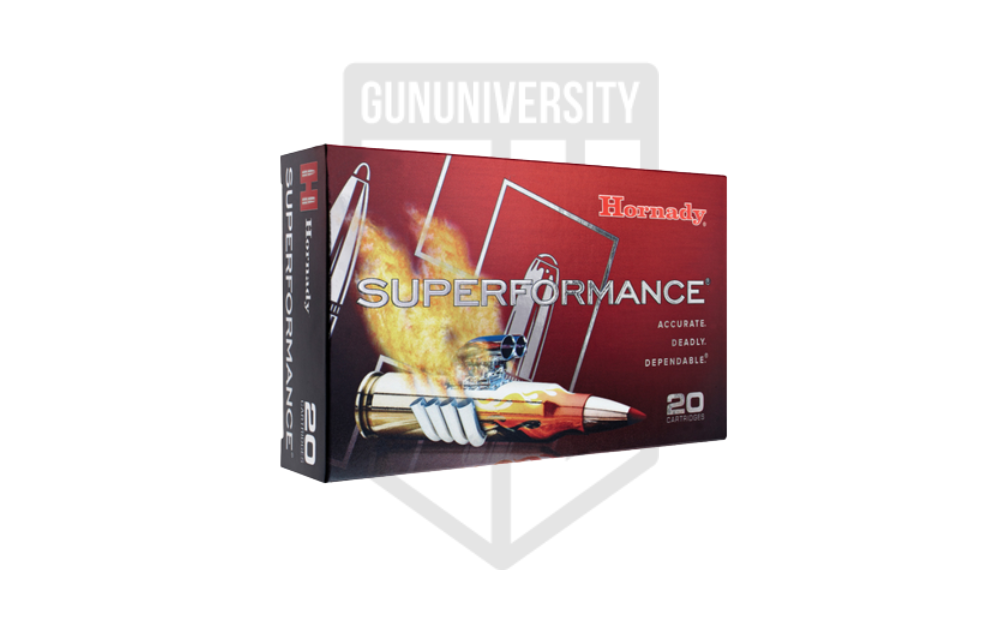
Hornady Superformance 270 Win 130 gr Polymer Tip CX
Marketplace |
Cost Per Round |
| gun.deals | $1.64 |
| Gritr Sports | $1.89 |
| Eurooptic | $2.24 |
Practice Ammo
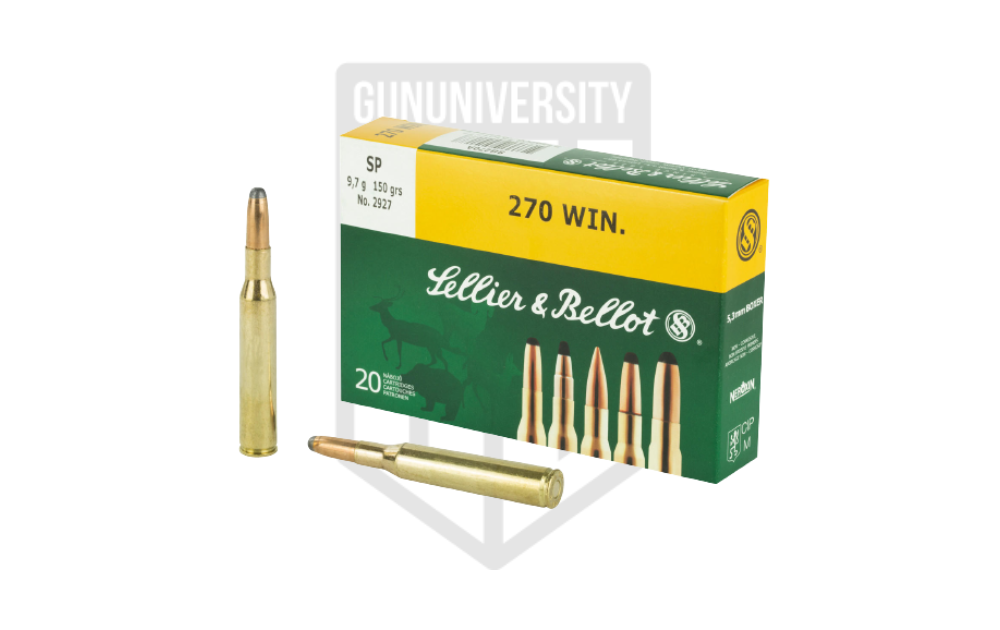
Sellier & Bellot 270 Win 150 gr SP
Marketplace |
Cost Per Round |
| gun.deals | $0.89 |
| Tactical Surplus USA | $1.05 |
| Palmetto State Armory | $1.20 |
30-06 Springfield Review
Because 30-06 Springfield is the parent cartridge of the 270 Win, you might think they’re not that different. In reality, 30-06 Springfield not only has a different history but varying performance. It’s a classic for a reason.
30-06 Springfield History and Purpose
They designed the 30-06 Springfield around 1906, with the 30-03 Springfield as its parent cartridge. The idea behind its creation was for a faster, lighter cartridge that could outpace the military’s existing standard chambering (the aforementioned 30-03 Springfield). Remember, this was the very-early 1900s, and our nation’s military was using bolt-action rifles like the M1903 Springfield.
When this cartridge was first officially launched for military use, it was called “cartridge, ball, caliber .30, Model of 1906.” That got shortened to M1906, and it was even further down the road before it became 30-06 Springfield. Interestingly, when it was a new cartridge, its effective range was estimated close to 5000 meters, which was totally inaccurate. Regardless, it became a standard issue round for service members until the Vietnam War.
Today, the 30-06 Springfield remains a favorite among certain groups of hunters. There are those who believe it’s an outdated round, but there are plenty of hunters who understand its ballistic capabilities and enjoy utilizing it. It’s a capable cartridge and great not only for hunting but for use as a brush gun, or even as a truck gun, if you’re so inclined.
Pros and Cons of 30-06 Springfield vs 270 Winchester
- Bullet Diameter – 30-06 Springfield uses a larger diameter bullet than 270 Win, which means the capability to create a larger, more devastating wound cavity.
- Energy – 30-06 Springfield delivers more energy, which means greater energy transfer on target.
- Ballistics – The 30-06 Springfield frequently delivers ballistic performance similar to that of many magnum cartridges.
- Recoil – The 30-06 Springfield produces more felt recoil than 270 Win.
- Trajectory – Because the 30-06 Springfield has a slightly larger, heavier bullet than the 270 Win, it has a more rapid drop rate.
Best Ammo for the 30-06 Springfield
Practice Ammo
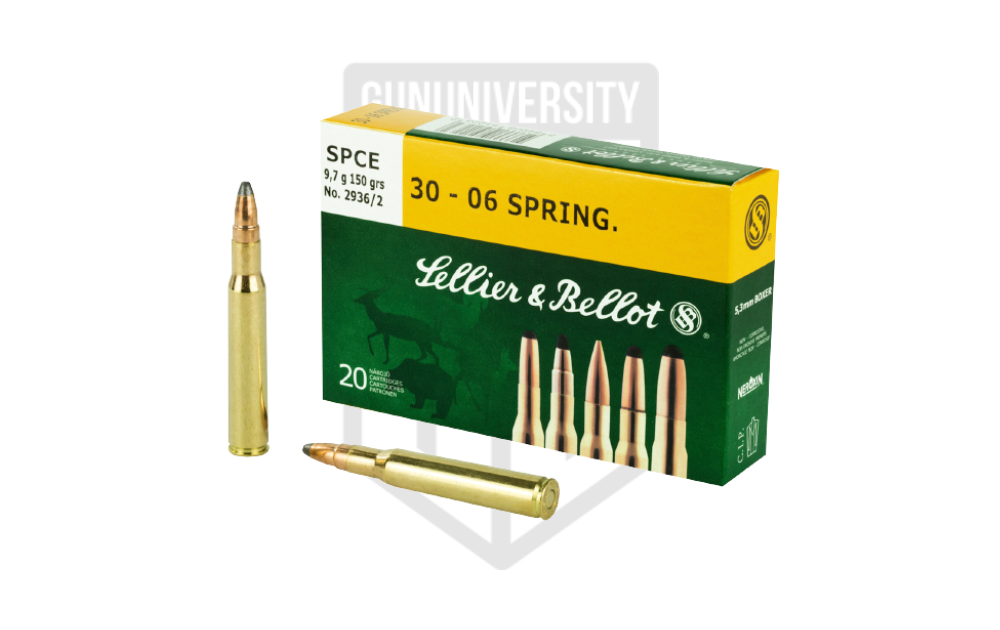
Sellier & Bellot 30-06 Springfield 150 gr FMJ
Marketplace |
Cost Per Round |
| Gun.deals | $0.88 |
| Tactical Surplus USA | $1.03 |
| Palmetto State Armory | $1.25 |
Match Ammo
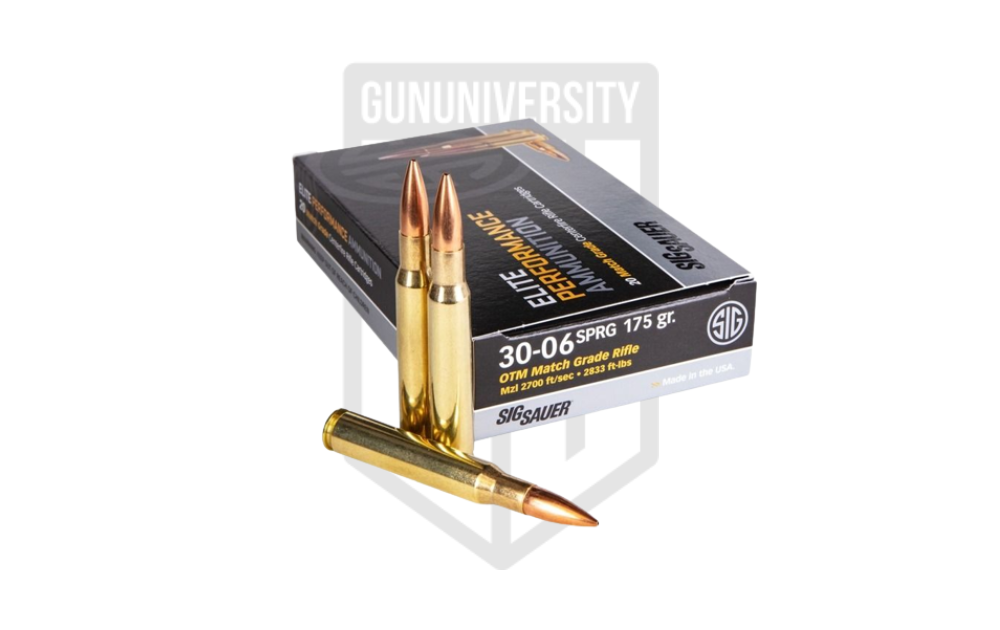
SIG Sauer Elite Performance 30-06 Springfield 175 gr OTM
Marketplace |
Cost Per Round |
| Gun.deals | $1.59 |
| Gritr Sports | $1.79 |
| Optics Planet | $1.86 |
Hunting Ammo
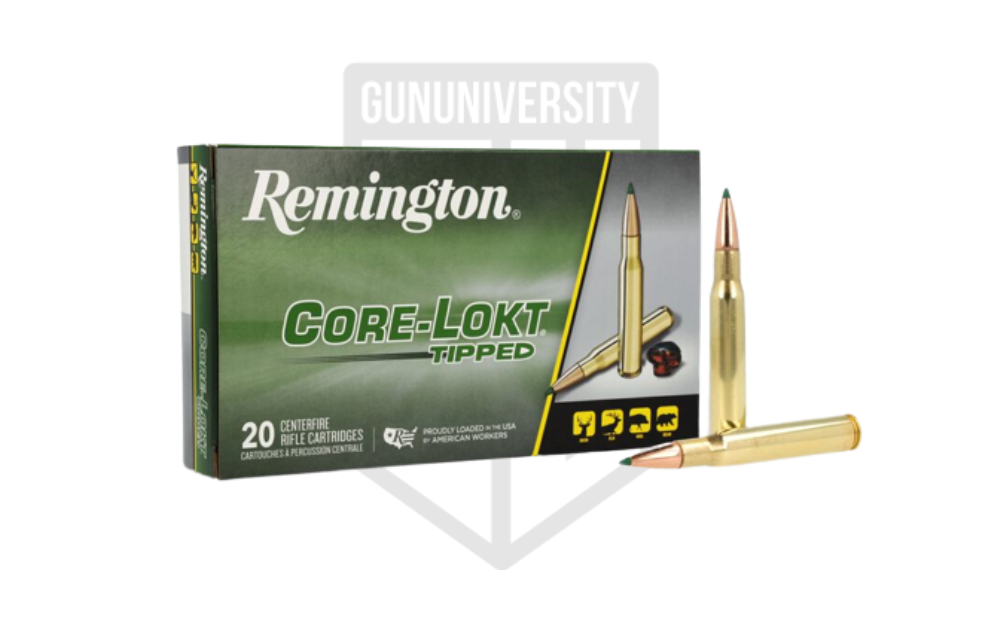
Remington Core-Lokt 30-06 Springfield 165 gr Polymer Tipped
Marketplace |
Cost Per Round |
| Gun.deals | $1.39 |
| Gritr Sports | $1.59 |
| Tactical Surplus USA | $1.72 |
Ballistics Comparison: 270 Win vs. 30-06 Springfield
There are some significant ballistic differences between the 270 Win and 30-06 Springfield. That’s right, even though the two cartridges are technically related from an ammunition design perspective, they perform differently. For example, 270 Win has a flatter trajectory than 30-06 Springfield, and 30-06 Springfield produces greater energy than 270 Win. But what does that look like on paper?
To compare cartridges beyond 100 yards, we’re going to take a look at a few different loads. First, let’s consider Nosler Trophy Grade 270 Win 150 grain Partition with a ballistic coefficient of 0.465 against Remington Core-Lokt 30-06 Springfield 165 grain Polymer Tipped with a ballistic coefficient of 0.447.
| Distance (yards) | Nosler Trophy Grade 270 Win 150 grain Partition. Velocity (fps) | Nosler Trophy Grade 270 Win 150 grain Partition. Energy (ft-lbs) | Remington Core-Lokt 30-06 Springfield 165 grain Polymer Tipped (fps) | Remington Core-Lokt 30-06 Springfield 165 grain Polymer Tipped (ft-lbs) |
|---|---|---|---|---|
| 0 | 2800 | 2611 | 2820 | 2913 |
| 100 | 2601 | 2254 | 2616 | 2507 |
| 200 | 2411 | 1926 | 2421 | 2147 |
| 300 | 2229 | 1655 | 2234 | 1829 |
| 400 | 2055 | 1407 | 2056 | 1549 |
| 500 | 1889 | 1189 | 1886 | 1303 |
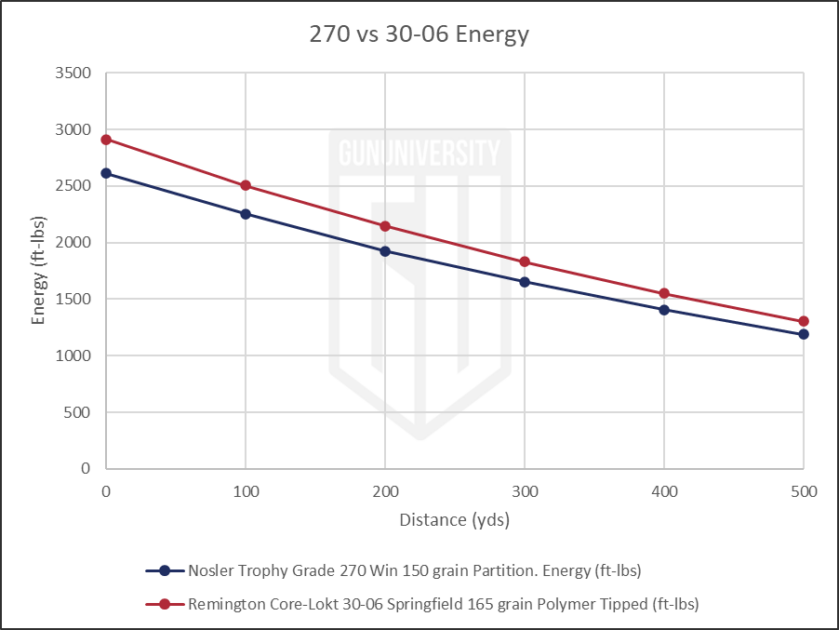
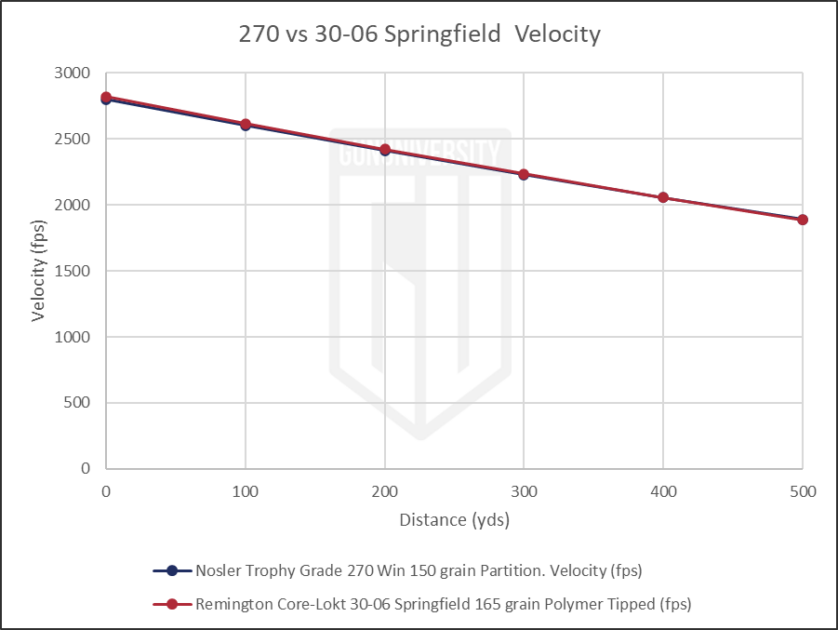
As you can see in the ballistic table above, the two cartridges deliver almost exactly the same velocity when measured from the muzzle. Interestingly, this similar performance maintains itself all the way to 500 yards—for velocity, that is. On the energy side, the 30-06 Springfield produces more right from the muzzle and continues to maintain an edge. Using these two loads as a comparison, the cartridges seem to be evenly matched for velocity while 30-06 Springfield wins for energy.
If we change over to target loads and compare Sellier & Bellot 270 Win 150 grain SP with a ballistic coefficient of 0.266 and Sellier & Bellot 30-06 Springfield 150 grain FMJ with a ballistic coefficient of 0.290? Does it stay the same, or do the results look different?
| Distance (yards) | Sellier & Bellot 270 Win 150 grain SP Velocity (fps) | Sellier & Bellot 270 Win 150 grain SP Energy (ft-lbs) | Sellier & Bellot 30-06 Springfield 150 grain FMJ Velocity (fps) | Sellier & Bellot 30-06 Springfield 150 grain FMJ Energy (ft-lbs) |
|---|---|---|---|---|
| 0 | 2641 | 2324 | 2953 | 2905 |
| 100 | 2317 | 1788 | 2634 | 2311 |
| 200 | 2016 | 1354 | 2336 | 1818 |
| 300 | 1676 | 1009 | 2058 | 1411 |
| 400 | 1495 | 744 | 1801 | 1080 |
| 500 | 1287 | 552 | 1568 | 819 |
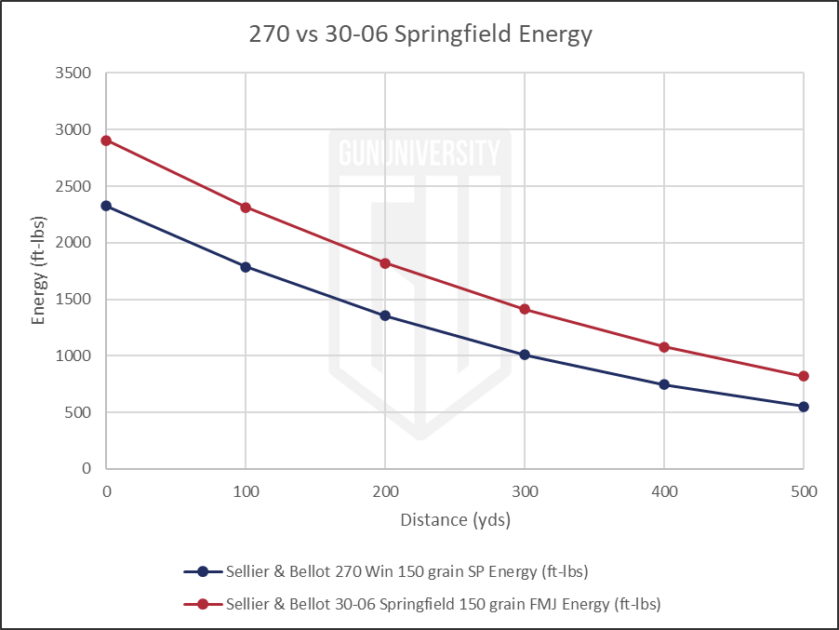

Comparing two different loads from the same manufacturer, we’re still seeing the 30-06 Springfield outpace the 270 Win under 500 yards. Let’s consider trajectory for the same two loads:
| Distance (yards) | Sellier & Bellot 270 Win 150 grain SP Drop (inches) | Sellier & Bellot 270 Win 150 grain SP Wind Drift (inches) | Sellier & Bellot 30-06 Springfield 150 grain FMJ Drop (inches) | Sellier & Bellot 30-06 Springfield 150 grain FMJ Wind Drift (inches) |
|---|---|---|---|---|
| 0 | -1.5 | 0.03 | -1.5 | 0.03 |
| 100 | 0.0 | 1.4 | 0.0 | 1.09 |
| 200 | -5.04 | 5.84 | -3.54 | 4.50 |
| 300 | -18.70 | 14.06 | -13.49 | 8.87 |
| 400 | -43.94 | 26.83 | -31.71 | 20.27 |
| 500 | -84.85 | 44.98 | -60.72 | 33.84 |
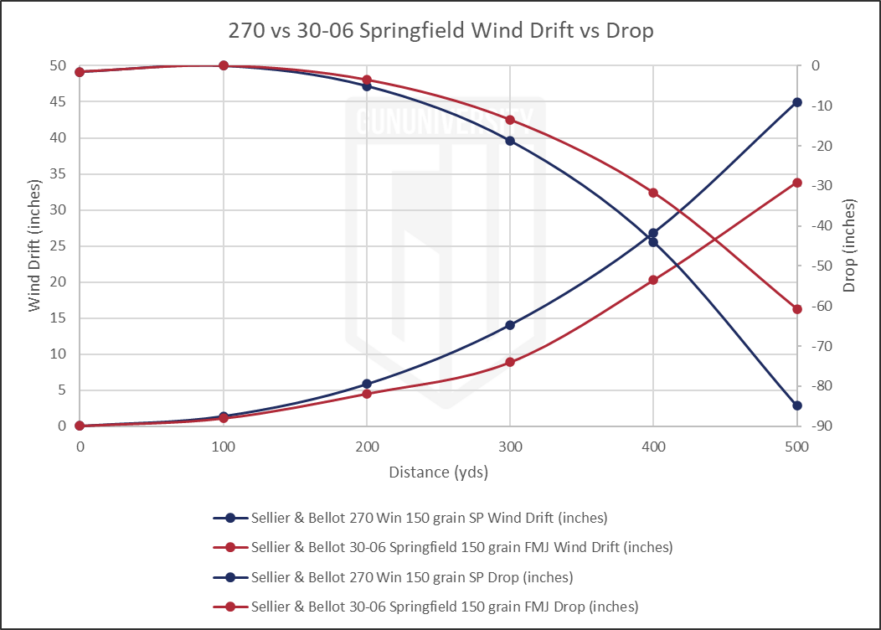
Considering that there’s other evidence that 270 Win produces a flatter trajectory than 30-06 Springfield, it might be surprising to see these loads don’t demonstrate that. What it comes down to is the fact that your specific load matters. With the correct load, 270 Win is going to outpace 30-06 Springfield for a flatter trajectory and steadier velocity. And, of course, 30-06 Springfield is going to produce a higher amount of energy, but usually it drops faster. Certain loads are simply superior and produce a better ballistic coefficient and greater results overall.
Of course, if you take the above ballistic charts at their face value, you’re going to surmise 270 Win isn’t really better than 30-06 Springfield. In fact, they might be somewhat evenly matched aside from a few variations here and there.
Our Take – 270 vs. 30-06
All guns are purpose driven tools, meaning you first must decide what the gun in question is going to be used for before dedicating yourself to a specific chambering. Although 270 Win and 30-06 Springfield might not seem to vary wildly, there are differences that can matter in the long run. A great example is the fact that if you’re a high round count shooter—and we mean truly high—the barrel on a 270 Win is going to outlast the barrel on a 30-06 Springfield (assuming the barrels are of equal quality). Similarly, if you’re going to be taking all your shots within a certain range, the faster drop rate of many 30-06 Springfield loads might not matter to you.
As a hunter, it’s tough to choose. There’s a greater variation of 30-06 Springfield rounds available, but that doesn’t mean it has the best availability at your local gun store. That said, it remains accurate today to say the 30-06 Springfield can take the vast majority of North American game animals. That particular claim depends on a few factors, but it’s true. It’s a nice, reliable cartridge, and it might be your ideal jack of all trades hunting cartridge.
If your goal is to make longer shots with less drop, the 270 Win might be the cartridge for you. As long as you’re using the right load, 270 Win will produce a flatter trajectory. It also produces less felt recoil than 30-06 Springfield, which can be a huge selling point. If you want to get every bit of distance possible out of a round, go with the 270 Win. It’s great for hunting a huge variety of animals, just with a bit less energy than 30-06 Springfield. One thing’s for sure, it’ll be easier on your shoulder.
We gave the win to the 30-06, but it really could have gone either way. Next, find out what our favorite riflfes are, chambered in 30-06 Springfield.
Recent Posts
November 21, 2025
November 20, 2025
November 17, 2025
November 17, 2025

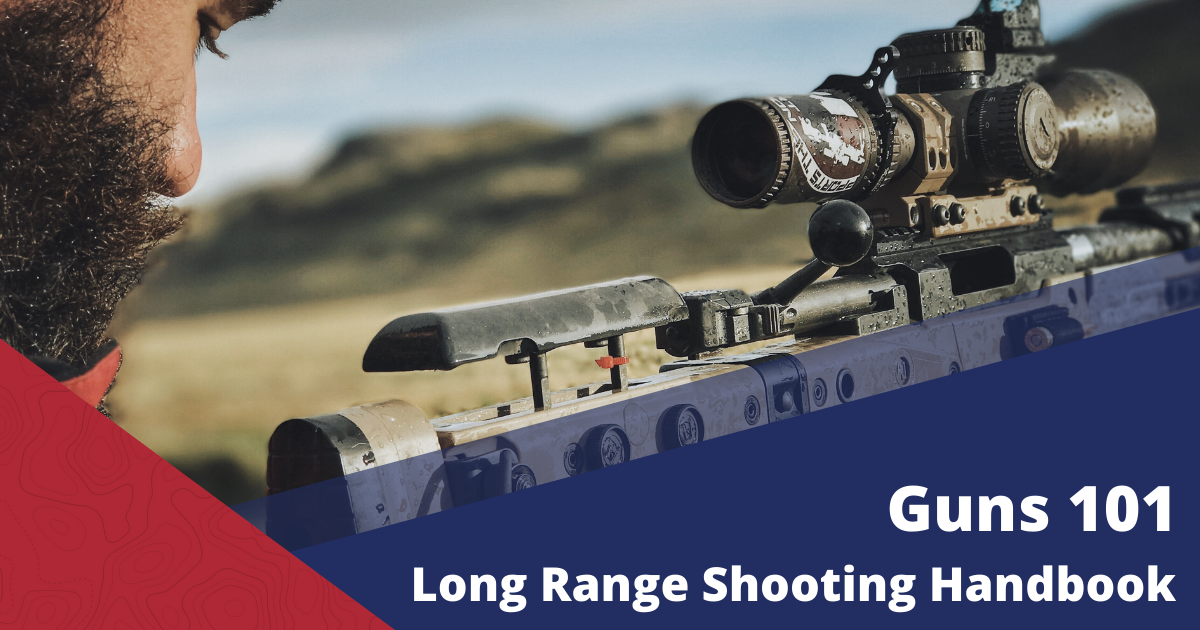
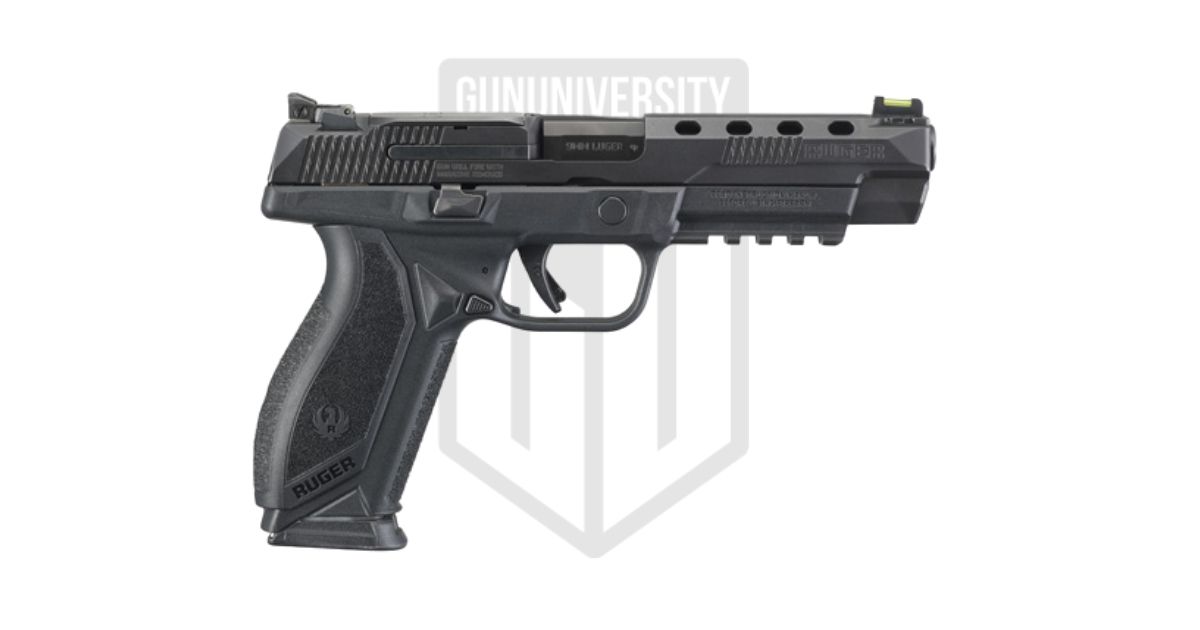
![Best Shooting Ear Protection for 2025 [Range-Tested!]](https://gununiversity.com/wp-content/uploads/2021/09/best-shooting-hearing-protection.jpg)
![Best 9mm Pistols [2025]: Ranked by Size & Use](https://gununiversity.com/wp-content/uploads/2021/09/Best-9mm-featured-1.jpg)